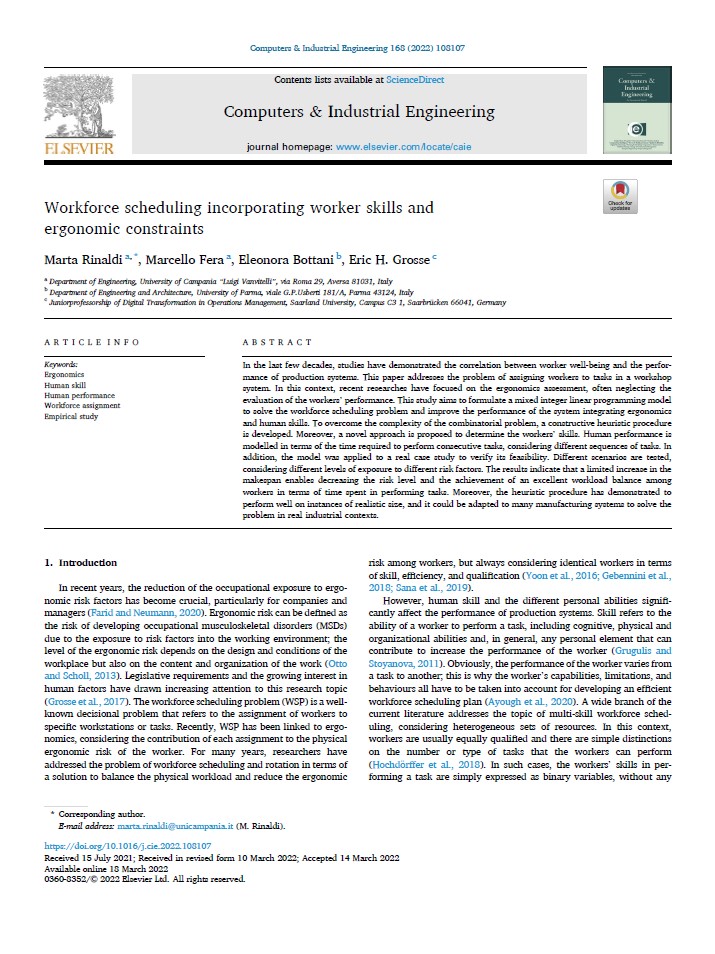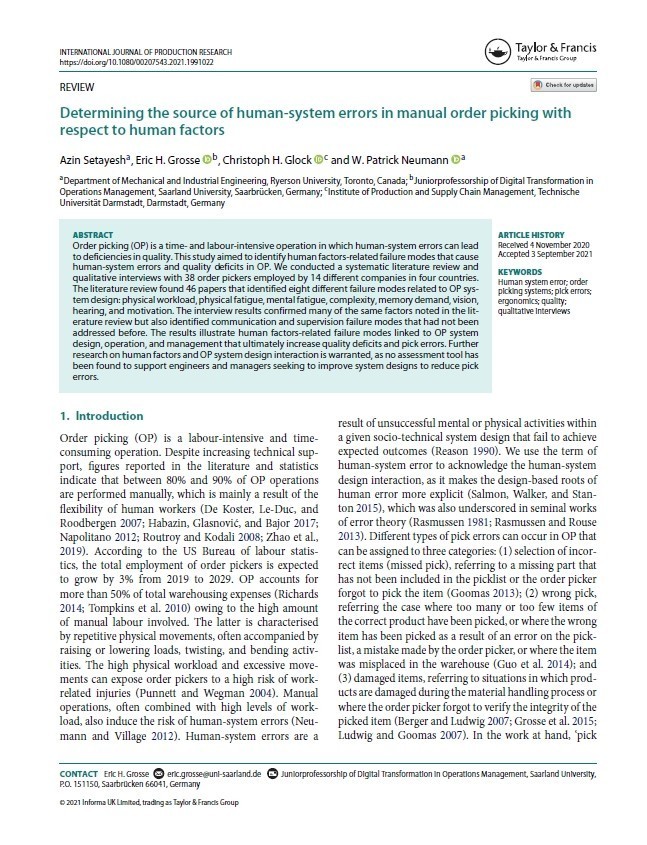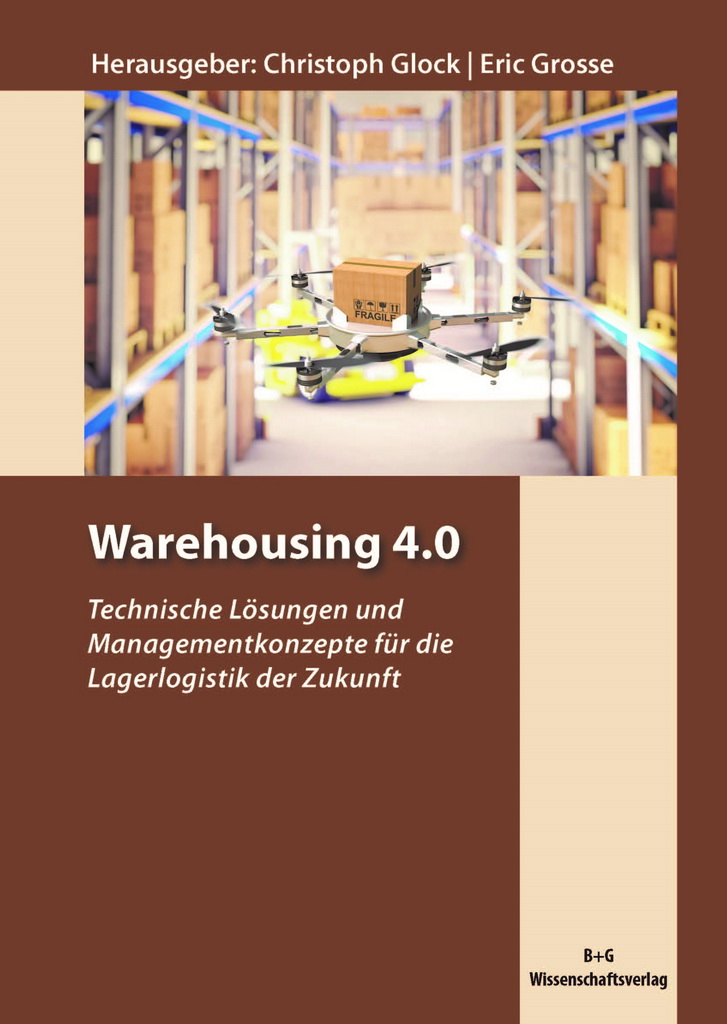Human Factors in Manual Materials Handling
Kurzbeschreibung
Goal: Investigate the economic and ergonomic consequences of the production and logistics system design employing human workers.
Publikationen
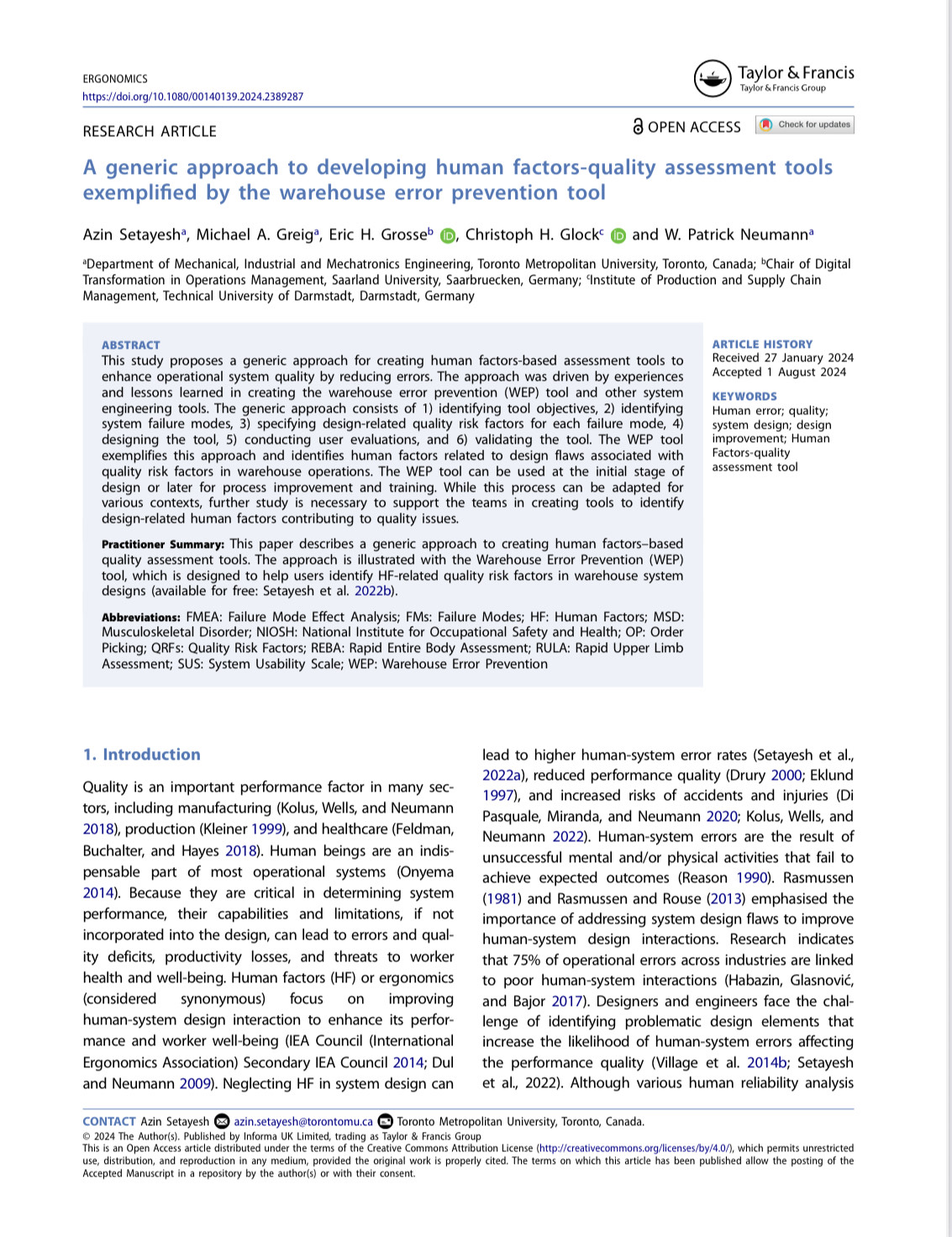
A generic approach to developing human factors-quality assessment tools exemplified by the warehouse error prevention tool
Setayesha, Greig, Grosse, Glock & Neumann (2024)
This study proposes a generic approach for creating human factors-based assessment tools to enhance operational system quality by reducing errors. The approach was driven by experiences and lessons learned in creating the warehouse error prevention (WEP) tool and other system engineering tools. The generic approach consists of 1) identifying tool objectives, 2) identifying system failure modes, 3) specifying design-related quality risk factors for each failure mode, 4) designing the tool, 5) conducting user evaluations, and 6) validating the tool. The WEP tool exemplifies this approach and identifies human factors related to design flaws associated with quality risk factors in warehouse operations. The WEP tool can be used at the initial stage of design or later for process improvement and training. While this process can be adapted for various contexts, further study is necessary to support the teams in creating tools to identify design-related human factors contributing to quality issues.
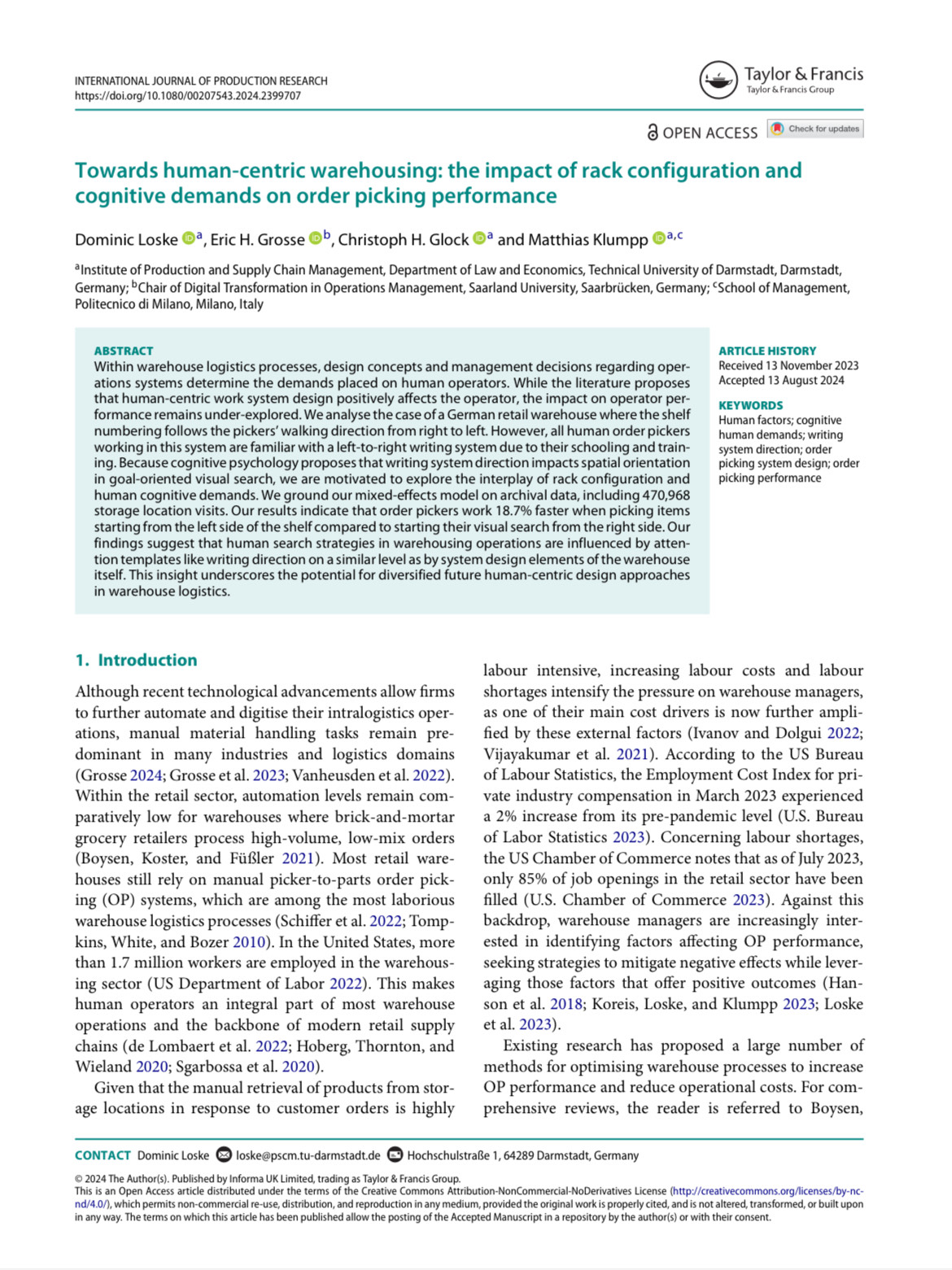
Towards human-centric warehousing: the impact of rack configuration and cognitive demands on order picking performance
Loske, Grosse, Glock & Klumpp (2024)
Within warehouse logistics processes, design concepts and management decisions regarding operations systems determine the demands placed on human operators. While the literature proposes that human-centric work system design positively affects the operator, the impact on operator performance remains under-explored. We analyse the case of a German retail warehouse where the shelf numbering follows the pickers' walking direction from right to left. However, all human order pickers working in this system are familiar with a left-to-right writing system due to their schooling and train-ing. Because cognitive psychology proposes that writing system direction impacts spatial orientation in goal-oriented visual search, we are motivated to explore the interplay of rack configuration and human cognitive demands. We ground our mixed-effects model on archival data, including 470,968 storage location visits. Our results indicate that order pickers work 18.7% faster when picking items starting from the left side of the shelf compared to starting their visual search from the right side. Our findings suggest that human search strategies in warehousing operations are influenced by attention templates like writing direction on a similar level as by system design elements of the warehouse itself. This insight underscores the potential for diversified future human-centric design approaches in warehouse logistics.

Evaluating usability, functionality, and usefulness of the warehousing error prevention tool
Setayesh, Grosse, Greig, Glock & Neumann (2024)
This paper presents an evaluation of the usability, functionality, and usefulness of the Warehouse Error Prevention (WEP) tool that consists of seven modules. The WEP tool is framed in a simple yes/no form, which can be used to identify human factors related to sources of pick errors in a warehouse. Thirty-three participants in 27 organisations from three different countries participated in a trial application and evaluation of the tool. The evaluation included a survey study and semi-structured interviews. Survey results show that participants agreed on the usability and functionality of the WEP tool. In the interviews, participants generally reported the WEP tool as being both accurate and functional with the potential to support engineers, ergonomists, and warehouse managers to improve order picking quality. Further quantitative field testing of the WEP tool’s potential to identify costly warehouse errors is needed.

Human-and-cost-centric storage assignment optimization in picker-to-parts warehouses
Diefenbach, Grosse & Glock (2023)
Warehouses are key for supply chain efficiency and company success. Over the past decade, warehouse operations have become more complex due to small-quantity orders with volatile demand patterns and the need for fast and error-free deliveries. In line with these developments, order picking is among the most critical tasks in warehouses, as it directly impacts the speed, availability and accuracy of the order. Although we see an increasing use of assistive and automation technology in order picking, manual tasks are still prevalent, and warehouse employment increases constantly. The high amount of manual work in order picking poses a risk environment for workers to develop injuries, which is why a research stream that focuses on the joint optimization of operational performance indicators and human well-being has emerged. This work contributes to this research area by developing an integrated storage assignment model that considers the vertical and horizontal dimension as well as the simultaneous minimization of the total order processing time and the minimization of the order picker’s total physical strain. Based on the results of numerical experiments, which are inspired by practical cases, we propose improved storage assignment policies for the case that order pickers follow the return or traversal routing strategy. This work contributes to further developing the research stream of human-centered warehousing and highlights implications for warehouse managers to improve working conditions with simultaneous consideration of performance optimization.
Workforce scheduling incorporating worker skills and ergonomic constraints
Rinaldi, Fera, Bottani & Grosse (2022)
Computers & Industrial Engineering 168(1)
In the last few decades, studies have demonstrated the correlation between worker well-being and the performance of production systems. This paper addresses the problem of assigning workers to tasks in a workshop system. In this context, recent researches have focused on the ergonomics assessment, often neglecting the evaluation of the workers’ performance. This study aims to formulate a mixed integer linear programming model to solve the workforce scheduling problem and improve the performance of the system integrating ergonomics and human skills. To overcome the complexity of the combinatorial problem, a constructive heuristic procedure is developed. Moreover, a novel approach is proposed to determine the workers’ skills. Human performance is modelled in terms of the time required to perform consecutive tasks, considering different sequences of tasks. In addition, the model was applied to a real case study to verify its feasibility. Different scenarios are tested, considering different levels of exposure to different risk factors. The results indicate that a limited increase in the makespan enables decreasing the risk level and the achievement of an excellent workload balance among workers in terms of time spent in performing tasks. Moreover, the heuristic procedure has demonstrated to perform well on instances of realistic size, and it could be adapted to many manufacturing systems to solve the problem in real industrial contexts.
Determining the source of human-system errors in manual order picking with respect to human factors
Setayesh, Grosse, Glock & Neumann (2021)
International Journal of Production Research
Order picking (OP) is a time- and labour-intensive operation in which human-system errors can lead to deficiencies in quality. This study aimed to identify human factors-related failure modes that cause human-system errors and quality deficits in OP. We conducted a systematic literature review and qualitative interviews with 38 order pickers employed by 14 different companies in four countries. The literature review found 46 papers that identified eight different failure modes related to OP system design: physical workload, physical fatigue, mental fatigue, complexity, memory demand, vision, hearing, and motivation. The interview results confirmed many of the same factors noted in the literature review but also identified communication and supervision failure modes that had not been addressed before. The results illustrate human factors-related failure modes linked to OP system design, operation, and management that ultimately increase quality deficits and pick errors. Further research on human factors and OP system design interaction is warranted, as no assessment tool has been found to support engineers and managers seeking to improve system designs to reduce pick errors.
Assistive devices for manual materials handling in warehouses: a systematic literature review
Glock, Grosse, Feldman & Neumann (2020)
International Journal of Production Research 59(2)
This paper evaluates how technical assistive devices for manual materials handling were analysed in the literature in a warehousing context. Works that discuss the economic and/or human factors impact of assistive devices on the warehousing system or the people employed therein were identified in a systematic literature review. Building on a conceptual framework proposed in this paper, our evaluation of the literature shows which types of assistive devices were analysed in the past, and from which perspective these devices were examined. Some works studied the devices exclusively from an operator well-being or an efficiency perspective, while several works analysed the devices’ performance in terms of both dimensions. Several works contained in our literature sample highlighted trade-offs between both ergonomic and economic measures and, within the first category, between alternative ergonomic indicators, which shows that assistive devices have to be evaluated carefully in light of their intended application. The paper further identifies research gaps and emphasises the need to understand the interactions between human- and system-related variables that can be supported by assistive devices in designing effective manual materials handling systems.
Accuracy evaluation of two markerless motion capture systems for measurement of upper extremities: Kinect V2 and Captiv
Steinebach, Grosse, Glock, Wakula & Lunin (2020)
Human Factors and Ergonomics in Manufacturing 30(4)
Motion capturing is a promising method to assess postures and human movements and, therewith, the risk of musculoskeletal injuries that could occur while performing manual tasks in industrial settings. To obtain a reliable risk assessment, the motion capture system used has to accurately measure body postures adopted by the worker during the task. This study evaluates the accuracy of two different motion capture systems, namely the Microsoft Kinect V2 and the Captiv system, for angles of upper extremities. For this purpose, an experimental study was conducted involving 12 subjects performing preset static postures and basic movements of the upper extremities, including elbow flexion, shoulder flexion and shoulder abduction. In addition, to examine whether self-occlusion or occlusion of body parts by work equipment has an impact on the accuracy of the Kinect V2, the subjects handled boxes during some of the tests. As a gold standard, a goniometer for static and an angle scale for dynamic exercises was used. The Captiv system shows high correlation coefficients (r > 0.93) and small mean absolute errors (< 5°) for all movements except for elbow flexion. The Kinect V2 has sufficient results for joint angles captured without occlusion as well, but the accuracy significantly decreases when occlusion occurs.
The Effect of Worker Fatigue on the Performance of a Bucket Brigade Order Picking System
Granotto, Sgarbossa, Glock & Grosse (2019)
9th IFAC Conference on Manufacturing Modelling, Management and Control (MIM 2019)
Order picking (OP) remains a very costly process with a high amount of manual human work. Different management policies have been developed in the past to improve the performance of order picking systems. Among these is the Bucket Brigade (BB), which is a self-organizing concept for manual OP systems with promising impact on the throughput rate. One general problem of manual OP systems is that worker fatigue can become an issue leading to decreased worker performance and an increased risk of injuries. This is one of the reasons why some researchers highlighted the importance of considering human factors in the design and operations of manual OP systems. This paper develops a mathematical model for managing a Bucket Brigade order picking (BBOP) system subject to worker fatigue. Numerical experiments illustrate the behavior of the model and how worker fatigue affects the performace of a BBOP system.
Evaluation der Akkuratheit von markerlosen Motion-Capture-Systemen zur ergonomischen Bewertung von Arbeitsplätzen in der Logistik
Steinebach, Grosse, Glock & Wakula (2019)
65. Frühjahrskongress der Gesellschaft für Arbeitswissenschaft 2019
Trotz der fortschreitenden Automatisierung werden Güter in der Logistik häufig noch manuell bewegt. Um körperliche Belastungen an den betroffenen Arbeitsplätzen mithilfe von Bewertungsverfahren zu bestimmen, können Motion-Capture-Systeme eingesetzt werden. Im Rahmen einer Laborstudie wurde überprüft, ob die Akkuratheit von zwei markerlosen Motion-Capture-Systemen ausreicht, um Bewegungen des Oberkörpers in realen Arbeitssituationen der Logistik zu erfassen. Hierbei handelt es sich um Microsoft Kinect V2 und das Captiv L7000 Premier-System. In einer Probandenstudie wurden ausgewählte Gelenkwinkel bei einer Aufgabe aus der Kommissionierung erfasst und dann mit einem Gold-Standard (Winkelskala) verglichen. Für das Captiv-System zeigen sich geringe mittlere absolute Fehler und eine hohe Korrelation mit dem Gold-Standard für alle Bewegungen. Kinect V2 besitzt ebenso eine hohe Akkuratheit bei einfachen Bewegungen, sofern es zu keinen Verdeckungen der Körpergliedmaßen kommt. Bei Verdeckung durch ein Arbeitsobjekt oder bei Selbstverdeckung nimmt die Akkuratheit des Systems jedoch signifikant ab.
An integrated cost and worker fatigue evaluation model of a packaging process
Glock, Grosse, Kim, Neumann & Sobhani (2018)
International Journal of Production Economics 207
This paper proposes a model for managing a packaging process of small products at a production line. The aim of the paper is to determine the optimal size of a box the products are stored in considering both financial (in terms of cost) and ergonomic (in terms of worker fatigue) aspects. The paper first develops a biomechanical model to estimate the expected fatigue-recovery parameters associated with the packaging process. Secondly, it proposes an optimization model that minimizes the total relevant cost of the packaging process consisting of the cost of packaging material and the cost of working time, which includes the time required for packing items, setting up and handling boxes, transporting boxes to the shipping area, and idle time cost. Thirdly, the fatigue-recovery approach is integrated into the optimization model to determine the optimal box size from a given set of alternative boxes as well as the work schedule that minimize the total relevant cost while satisfying the upper bound on the estimated total (accumulated) fatigue level. The developed model is then analysed in a numerical experiment inspired by a case observed in industry. The results of the numerical analysis show that smaller box sizes are less sensitive to changes in the maximum permitted fatigue level and that they lead to lower total relevant cost for low wage cost. Larger boxes, in turn, are recommended for higher wage cost. The maximum permitted fatigue level and the box sizes also influence the fatigue range experienced by the worker as well as the share of productive time the worker spends on the job.
An integrated model to improve ergonomic and economic performance in order picking by rotating pallets
Glock, Grosse, Abedinnia & Emde (2018)
European Journal of Operational Research 273(2)
This paper studies manual order picking activities in a warehouse where items are stored on pallets in two rows one above the other. Items stored on the pallets may be heavy, and manually picking the items may require excessive bending and stretching, which results in high spinal loads on the order picker associated with high injury risks. For this scenario that can frequently be observed in practice, this paper proposes an integrated model that supports the planning of order picking operations and pallet rotations taking account both of the time required for completing a set of orders as well as the spinal load on the order picker and the consequent injury risks. The results of a numerical experiment indicate that selectively rotating pallets may both reduce order picking time as well as the load on the order picker, leading to a quicker and less risky order picking process. The model proposed in this paper supports the decision of which pallet to rotate (and which not to rotate) against the company’s cost objectives and its strive for worker well-being.
An integrated storage assignment method for manual order picking warehouses considering cost, workload and posture
Calzavara, Grosse, Glock & Sgarbossa (2018)
International Journal of Production Research 57(2)
This paper presents an integrated storage assignment method for low-level picker-to-parts order picking warehouses taking into account economic and ergonomic objectives. Three different pallet rack layouts are studied in this paper, namely a) picking from full pallets on the floor, b) picking from half pallets on the floor, and c) picking from half pallets on the upper rank of the shelf. First, cost functions are developed to assess the total order picking performance impact of these different pallet rack layouts. Second, with regard to workload, the metabolic cost and energy expenditure rates for picking from the different rack layouts under study are derived. Third, for assessing the working posture during order picking, the OWAS Index is used where data is collected using a motion capturing system. The developed models are combined to propose a heuristic storage assignment procedure that supports the decision of which item to store on which pallet. The developed storage assignment method is then applied to an industrial case study. The results of the paper support warehouse managers in assessing the order picking storage assignment from an ergonomics viewpoint and in estimating its impact on financial order picking performance.
The effects of human fatigue on learning in order picking: an explorative experimental investigation
Winkelhaus, Sgarbossa, Calzavara & Grosse (2018)
16th IFAC Symposium on Information Control Problems in Manufacturing
Order picking is one of the most important processes in warehouse logistics as it impacts the efficiency of the whole supply chain. Despite many opportunities for automating order picking tasks, it is still performed manually in many companies. Although human factors are of prime importance for order picking performance, the interaction between human factors and the order picking system is still not fully understood. This paper presents the results of an experimental study that systematically investigated the influences of fatigue and learning on order picking performance. This study focuses on procedural and declarative learning and their impact on order picking performance as well as the effects of fatigue on learning. Preliminary findings of the experimental study show that a reversed u-shaped interrelation between physical fatigue and cognitive performance is likely, whereas mental fatigue appears to have a negative influence on learning effects.
Analytical models for a joint posture and fatigue analysis in order picking
Calzavara, Sgarbossa, Grosse & Glock (2017)
International Conference on Industrial Engineering and Systems Management
This paper presents analytical models for assessing worker posture and fatigue in manual order picking activities and their performance impact. The OWAS (Ovako Working Posture Analysing System) index and the energy expenditure concept are combined to evaluate the order picking process with respect to health risks and to assess the performance impact of the order picking system from a human factors point of view.
Incorporating human factors into decision support models for production and logistics: current state of research
Grosse, Calzavara, Glock & Sgarbossa (2017)
IFAC-PapersOnLine 50(1)
Decision support models for production and logistics have neglected human factors to a large extent in the past. For this reason, researchers have called for the development of more realistic planning models for production and logistics problems incorporating human factors. This call has recently been addressed by an increasing number of innovative approaches, which makes the study of human factors in decision support models for production and logistics a more and more maturing research field. The aim of this paper is to present the evolution of works that incorporate human factors into decision support models for production and logistics. For this reason, a systematic literature review is performed. The results of the literature review reveal the current state of research and highlight areas and approaches where additional research is promising.
Verbesserung der Arbeitsplatzqualität in der Lagerhaltung durch ergonomische Arbeitsplatzgestaltung
Glock, Grosse & Broens (2017)
Warehousing 4.0 - Technische Lösungen und Managementkonzepte für die Lagerlogistik der Zukunft (pp.257-278) | Edition: 1 | Chapter: 17
Die Tätigkeiten in der Lagerhaltung, allen voran die Kommissionierung, sind trotz des Einsatzes technischer Hilfsmittel und Automatisierungsmöglichkeiten oftmals von einem hohen Einsatz an manuellen Lastenbewegungen und -handhabungen geprägt. Auch in Zukunft wird die manuelle menschliche Arbeit aufgrund von Flexibilitätsvorteilen in vielen Unternehmen eine wichtige Rolle in der Lagerhaltung einnehmen. Dieser Beitrag gibt einen Überblick über Verfahren zur Belastungsbewertung von Lagerarbeitsplätzen, die genutzt werden können, um Potenziale für ergonomische Verbesserungen zu identifizieren. Schließlich werden zwei Anwendungsbeispiele vorgestellt, bei denen unterschiedliche Formen der Paletteneinlagerung in der Kommissionierung in Bezug auf die entstehende Mitarbeiterbelastung untersucht werden.
Ergo-lot-sizing: An approach to integrate ergonomic and economic objectives in manual materials handling
Battini, Glock, Grosse, Persona & Sgarbossa (2017)
International Journal of Production Economics 185
Over the last decades, academics and practitioners have paid much attention to lot-sizing, which determines economic order and production quantities by balancing inventory holding and setup costs. Recently, researchers have started to integrate sustainability issues into lot-sizing models. The focus of these works has been on environmental and economic dimensions of sustainability, however, while only few contributions studied the social aspect of this problem. Especially in in-house logistics, where a high amount of manual material handling is performed, lot-sizing decisions can have a significant impact on workload and human performance, which can have a strong influence on ergonomic parameters and thus worker welfare.
Models for an ergonomic evaluation of order picking from different rack layouts
Calzavara, Glock, Grosse, Persona & Sgarbossa (2016)
IFAC-PapersOnLine 49(12)
This paper evaluates ergonomics indicators of order picking activities related to different pallet picking alternatives, namely a) picking from full pallets on the floor, b) picking from half pallets on the floor, and c) picking from half pallets on the upper rank of the shelf. The OWAS (Ovako Working posture Analysing System) index and the energy expenditure level are used to evaluate the different systems. The necessary data was collected in a field analysis using a motion capturing system. Mathematical models for the ergonomics analysis are developed and risk factors related to musculoskeletal disorders associated with the specific pallet picking system are discussed.
Analysis of economic and ergonomic performance measures of different rack layouts in an order picking warehouse
Calzavara, Glock, Grosse, Persona & Sgarbossa (2016)
Computers & Industrial Engineering 111
Manual order picking ranks among the most time- and cost-intensive activities in warehouses, and it has frequently been studied in the past. The aim of existing studies was to improve the operational efficiency of order picking processes mainly by developing planning models that help to reduce the time that is needed for order picking. As order picking is still performed manually with technical support in most warehouses, human workers play an important role for order picking performance. Although it is recognized that manual material handling activities in warehouses expose workers to a high risk of developing musculoskeletal disorders, integrated planning approaches that consider both economic and ergonomic objectives in order picking design are still rare. This paper contributes to closing this research gap by developing economic and ergonomic performance measures for the case where orders are picked from pallets, half-pallets and half-pallets equipped with a pull-out system. The comprehensive analysis of the different rack layouts shows that there are opportunities to replace the traditional pallet storage system by half-pallets with a pull-out system on the lower rank to improve both ergonomics and economic performance.
Human factors in order picking: A content analysis of the literature
Grosse, Glock & Neumann (2016)
International Journal of Production Research 55(5)
Order picking (OP) is one of the most labour- and time-intensive processes in internal logistics. Over the last decades, researchers have developed various mathematical planning models that help to increase the efficiency of OP systems, for example, by optimising storage assignments or by specifying routes for the order pickers that minimise travel distance in the warehouse. Human characteristics that are often a major determinant of OP system performance have, however, widely been ignored in this stream of research. This paper systematically evaluates the literature on manual OP systems and conducts a content analysis to gain insights into how human factors (HF) have been considered and discussed in the scientific literature. The results of the analysis indicate that management-oriented efficiency criteria dominated prior research on OP, and that there is a clear lack of attention to HF in the design and management of OP systems. This poses an opportunity for research and design of manual OP systems.
Using qualitative interviewing to examine human factors in warehouse order picking: Technical note
Grosse, Dixon, Neumann & Glock (2016)
International Journal of Logistics Systems and Management 23(4)
The effect of human factors on the performance of labour-intensive order picking processes has thus far been relatively understudied in the operations and logistics management literature. This technical note offers guidance to researchers and managers regarding how qualitative methods can be used to assess human factors in order picking. The paper first discusses manual tasks in this process and highlights where human factors influence the outcomes of time, quality and worker health. This discussion is used to inform the development of a qualitative example interview guide to investigate the order picking system. The paper provides step-by-step guidance for using interviewing to assist researchers and logistics managers that emphasises considering human factors in the planning of order picking processes. Using qualitative methods to integrate human factors into order picking processes can help to avoid workers’ exposure to musculoskeletal disorders and improve the quality and efficiency of order picking systems.
Human energy expenditure in order picking storage assignment: A bi-objective method
Battini, Glock, Grosse, Persona & Sgarbossa (2016)
Computers & Industrial Engineering 94
Order picking is the most time-consuming and labor-intensive activity in warehousing. Due to the need to frequently handle items, order picking requires high human energy expenditure and poses a risk environment for workers to develop musculoskeletal disorders. The storage assignment policy in use has a significant impact on human energy expenditure and fatigue during the picking process, but this impact is usually not considered in (management-oriented) decision support models for storage assignment. This paper models and analyzes the integration of human energy expenditure as one dimension of ergonomics into the storage assignment problem using a bi-objective approach that considers both total order picking time and human energy expenditure. Time and energy expenditure depend on the main features of the order picking system, such as item characteristics, item popularity, order profiles, and physical dimensions of the shelf and locations. Pareto frontiers are constructed to understand the impact of the storage assignment policy on the objective functions. Subsequently, a quantitative approach is developed to integrate the energy expenditure rate into the time estimation for a general order picking system based on the introduction of rest allowance. Finally, the results of the model are analyzed and suggestions for the practical application of the model are presented.
Ergo-Lot-Sizing: Considering Ergonomics in Lot-Sizing Decisions
Battini, Glock, Grosse, Persona & Sgarbossa (2015)
IFAC-PapersOnLine 48(3)
One aspect that has mostly been overlooked in traditional economic lot-sizing is the implication of decisions on manual tasks and workload. Although lot-sizing decisions can have a significant impact on required manual material handling and on human performance, works that consider ergonomic aspects in lot-sizing are rare. This paper presents a model that integrates ergonomic aspect in terms of human energy expenditure and rest allowance in a traditional lot-sizing model. The behavior of the model is analyzed in a numerical study, showing its ability to reflect manual workload, and that ergonomic aspects should be considered in lot-sizing decisions.
Human Factors in Order Picking System Design: A Content Analysis
Grosse, Glock & Neumann (2015)
IFAC-PapersOnLine 48(3)
Order picking is considered as one of the most labor- and time-intensive processes in internal logistics. Over the last decades, researchers have developed various planning models that help to increase the efficiency of order picking systems, while important human characteristics of the order pickers have widely been ignored. This paper presents an attempt to systematically evaluate the literature on order picking planning models and uses a content analysis approach to analyses the literature sample with a special focus on human factors. The results show a clear research gap in considering human factors aspects in order picking planning models.
The effect of worker learning on manual order picking processes
Grosse & Glock (2014)
International Journal of Production Economics 170
Order picking is a time-intensive and costly logistics process as it involves a high amount of manual human work. Since order picking operations are repetitive by nature, it can be observed that human workers gain familiarity with the job over time, which implies that learning takes place. Even though learning may be an important source of efficiency improvements in companies, it has largely been neglected in planning order picking operations. Mathematical planning models of order picking that have been published earlier thus provide an incomplete picture of real-world order picking, which affects the quality of the planning outcome. To contribute to closing this research gap, this paper presents an approach to model worker learning in order picking. First, the results of a case study are presented that emphasize the importance of learning in manual order picking. Subsequently, an analytical model is developed to describe learning in order picking, which is then evaluated with the help of numerical examples. The results show that learning impacts order picking efficiency. In particular, the results imply that worker learning should be considered when planning order picking operations as it leads to a better predictability of order throughput times. In addition, the effects of learning are relevant for the allocation of available resources, such as the allocation of workers to different zones of the warehouse. The results of the numerical analysis indicate that it is beneficial to assign workers with the lowest learning rate in the workforce to the fast moving zone to gain experience.
Incorporating human factors in order picking planning models: Framework and research opportunities
Grosse, Glock, Jaber & Neumann (2014)
International Journal of Production Research 53(3)
Order picking (OP) activities, essential to logistics operations, are laborious and time-intensive. Humans are central actors in the OP process and determine both OP effectiveness and efficiency. Many researchers have developed models for planning OP activities and increasing the efficiencies of such systems by suggesting different warehouse layouts, OP routes or storage assignments. These studies have, however, ignored workers’ characteristics, or human factors, suggesting that they cannot be substantiated, which led to only partially realistic results. This paper proposes a conceptual framework for integrating human factors into planning models of OP activities and hypothesises that doing so improves the performance of an OP system and workers’ welfare. The framework is based on a systematic literature review that synthesises findings documented in the OP and human factors literature. The results of the paper may assist researchers and practitioners in designing OP systems by developing planning models that help in enhancing performance and reducing long-term costs caused by work-related inefficiencies.
A simulated annealing approach for the joint order batching and order picker routing problem with weight restrictions
Grosse, Glock & Ballester-Ripoll (2014)
International Journal of Operations and Quantitative Management 20(2)
This paper studies the joint order batching and order picker routing problem in conventional multi-parallel-aisle picker-to-part order picking systems. It complements prior publications by considering a capacity constraint that is formulated as a function of total item weight, instead of item count. A mathematical model is formulated and a simulated annealing algorithm is developed to batch orders and to determine pick tours. The intention of the paper is to provide a more realistic model and to improve classical batching and routing heuristics. It thereby pays special attention to the practical applicability of the model. The proposed methods are compared and evaluated in an extensive numerical study, and it is shown that the developed approach leads to an improved solution for the joint order batching and order picker routing problem, as compared to classical heuristics for this problem.
The effect of worker learning and forgetting on storage reassignment decisions in order picking systems
Grosse, Glock & Jaber (2013)
Computers & Industrial Engineering 66(4)
Order picking is a time-intensive and costly logistics activity as it involves a high amount of manual work. Prior research has mostly neglected the influence of human factors on the efficiency of order picking systems. This paper develops a mathematical model that investigates the impact of learning and forgetting of a heterogeneous workforce on order picking time and, consequently, on storage assignment decisions. In particular, the paper investigates when to change a storage assignment and when to keep it if learning and forgetting occur among the members of an order picking workforce. The results show that learning and forgetting should be considered in order to achieve a proper planning of storage assignment strategies.
An experimental investigation of learning effects in order picking systems
Grosse & Glock (2013)
Journal of Manufacturing Technology Management 24(6)
Purpose: The purpose of this paper is to study the prevalence of human learning in the order picking process in an experimental study. Further, it aims to compare alternative learning curves from the literature and to assess which learning curves are most suitable to describe learning in order picking. Design/methodology/approach: An experimental study was conducted at a manufacturer of household products. Empirical data was collected in the order picking process, and six learning curves were fitted to the data in a regression analysis. Findings: It is shown that learning occurs in order picking, and that the learning curves of Wright, De Jong and Dar-El et al. and the three-parameter hyperbolic model are suitable to approximate the learning effect. The Stanford B model and the time constant model led to unrealistic results. Practical implications ‐ The results imply that human learning should be considered in planning the order picking process, for example in designing the layout of the warehouse or in setting up work schedules. Originality/value: The paper is the first to study learning effects in order picking systems, and one of the few papers that use empirical data from an industrial application to study learning effects.
Human factors in order picking systems
Grosse & Glock (2013)
ZWF Zeitschrift fuer Wirtschaftlichen Fabrikbetrieb 108(4)
This paper studies human factors in picker-to-part order picking systems. It first develops a process model of manual order picking and discusses the relevance of human factors in the different process steps. It then illustrates how human factors can be integrated into planning models of order picking. The paper suggests that incorporating human factors in the planning process of order picking may improve order picking performance, quality and worker health.
Lerneffekte in der Kommissionierung
Grosse & Glock (2012)
ZWF Zeitschrift fuer Wirtschaftlichen Fabrikbetrieb 107(4)
Kurzfassung Dieser Beitrag geht der Frage nach, inwieweit menschliches Lernen die Performance von Kommissionierlagern beeinflusst und wie dieses in die Planung von Kommissioniersystemen integriert werden kann, um die Kosten der Kommissionierung zu reduzieren. Zu diesem Zweck wurden Daten in einem manuellen Kommissionierlager eines mittelständischen Unternehmens erhoben und gezielt auf Lerneffekte untersucht. Es zeigt sich, dass Lerneffekte in der Kommissionierung auftreten und einen wertvollen neuen Ansatz zur Kostenreduzierung für das Management der Intralogistik bilden.


